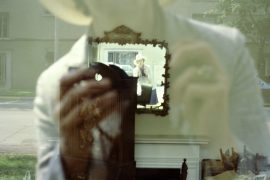by Azzurra Immediato
_
Yellow, Orange, Red Zone. We have become inhabitants of a chromatic spectrum, becoming, ourselves, the spectri of something that still appears unknown. The certainty is having to stay in our homes, as much as possible, to try to stop the virus’ spread. And what is left on the streets? After the bold crowds of the last few days, once again we will be with our gazes turned outwards, guided by more pregnant reasons, by stricter regulations and once again perhaps, it will be time to stop and think, without that unusual euphoria – or terror of the unknown – which, however, did not help us to reason much. Where can the rational path start to review what is happening under the right perspective? We could begin to deal with the forgotten concept of consistency and principle. Remember last spring? Whoever allowed activities to remain open for the community was considered a hero. Then came the summer, with a general deafness of mind, and the autumn brought us back to the pandemic hell, an emergency in which, as the news tell us, those heroes are attacked by society as new infectors, pawns of conspiracy by the poker that be and… no, please, we can’t go on. We are talking about people, faces, lives, portraits of a humanity overwhelmed by the whirlwind of the pandemic.
Fortunately, there are those who look at reality from other perspectives: Marco Gualazzini, internationally renowned photojournalist, already winner of the World Press Photo 2019; Gian Luca Signaroldi, communications manager, Pietro Gerboni, photojournalist and video maker focused on social and immigration issues; Mariachiara Illica Magrini, journalist and documentary maker. Four minds from Parma – whose fame, however, goes well beyond the national borders – who gave life to Resilienti 2020: dietro la maschera, oltre il virus [Resilients 2020: behind the mask, beyond the virus], a reportage, an exhibition, a story, a form of participatory communication, in short, a compendium of thought captured through photography. Now in the Orange Zone, we met – at a safe distance, therefore, online – the four authors and go deeper in their investigation.
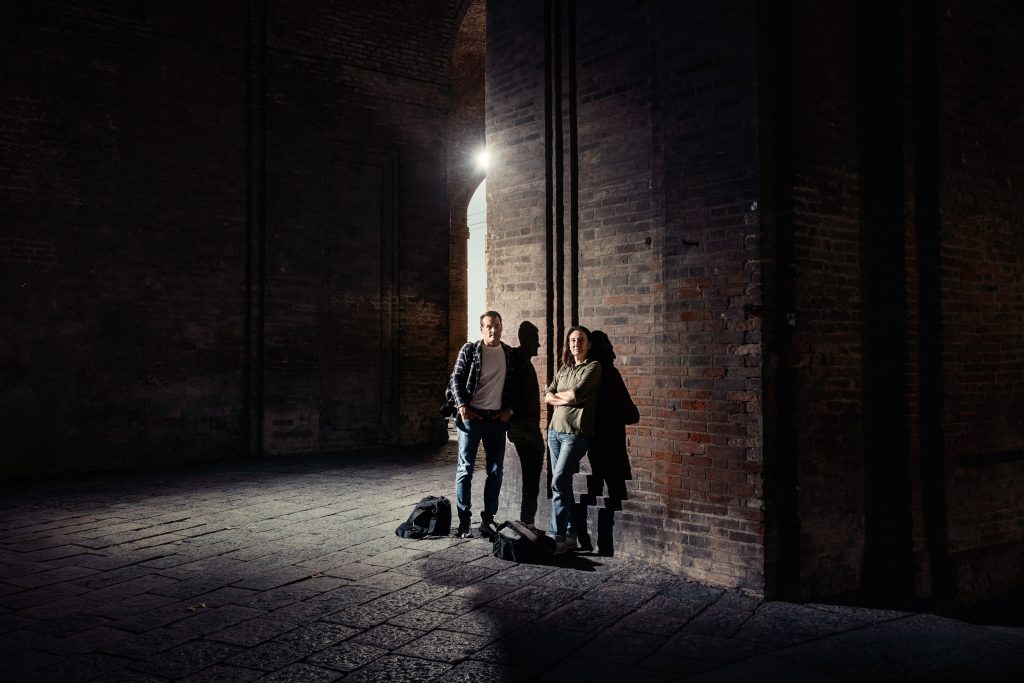
Resilienti 2020, a project that you have defined as “an ephemeral path, a hybrid between photography, serial communication and inclusive and shared artistic installation “whose goal is to tell the Covid-19 emergency during the first lockdown of 2020. What need came up from the confrontation between you and how did you decide to develop this shared journey?
M. GUALAZZINI: I have known Luca for some years now and, with Unsocials, we have worked together on several projects. Since the March crisis occurred, our collaboration has been further consolidated. During the months of the lockdown I went out several times to document what was happening in Parma, and there were episodes that made me think. First of all, the first time I had access to a Covid ward in the hospital. I arrived feeling fearful. I had covered a report in Congo, a few months earlier, on the Ebola epidemic in progress – a photo reportage from 2019 published in various newspapers, ed. – so I thought I was in some respects “prepared”. But no. As a photographer, I was assigned to Dr. Antonio Nouvenne and followed him among the sick people. I was fascinated by the confidence with which he moved in what for him was simple routine; and while I felt my heart in my throat, with him we moved through the corridors as if we were immune to that unknown virus. He kept thinking aloud, asking questions, proposing, making and cancelling hypotheses. He analyzed, looked the enemy in the face, never letting the slightest discomfort show through. I am talking about March and, in March, the enemy was not Covid, it was still the unknown. Today Covid begins to take shape, we almost live with it, but at the time it was something completely new. And his confidence, not so much towards the virus itself, but towards the unknown, made me less fearful. From there I started asking myself other questions: who takes away the trash from my house at night? Who takes responsibility for touching these bags, when we were even told to disinfect the groceries? Shopping: who is that woman behind the mask at the cashier? Knowing that people like Nouvenne, or Romina, or Gianni, or Annarita and others like them were out there for us, watching our backs, made me feel protected. So, talking to Luca, we looked for a way to celebrate them, showing their faces without masks, with the desire that those faces could reach the greatest number of Parmesans.
G. L. SIGNAROLDI: The relationship with Marco is something that goes beyond the professional side, perhaps even beyond friendship; sometimes we find ourselves looking at the same things the same way, even the small things, especially the small things. I remember one day we were in Macerata for a shooting and, outside the door of the house where we were staying, the apron flapping in the wind of a lady perched at the top of the road fascinated us so much that we talked about it all evening. But this time, today as during the first lockdown, it’s not a small thing. During those days in the agency there was just me, as all my collaborators and partners were at home in smart-working. We were right in the middle of moving headquarters, a real white, sickly and immobile moment of suspension. The deserted streets, the fear of breathing the air, the sound of footsteps asking for a wordless refreshment to thoughts. The desire to do something for others was very strong, without thinking of anything other than making a contribution. When Marco told me that he had entered the trenches, at the hospital in our city, I saw with his eyes all the answers to the questions that were whirling in my mind. And those answers were the faces of the people who, in silence, put themselves on the front line every day to guarantee the same life that every person is entitled to. Behind the mask, beyond the virus.
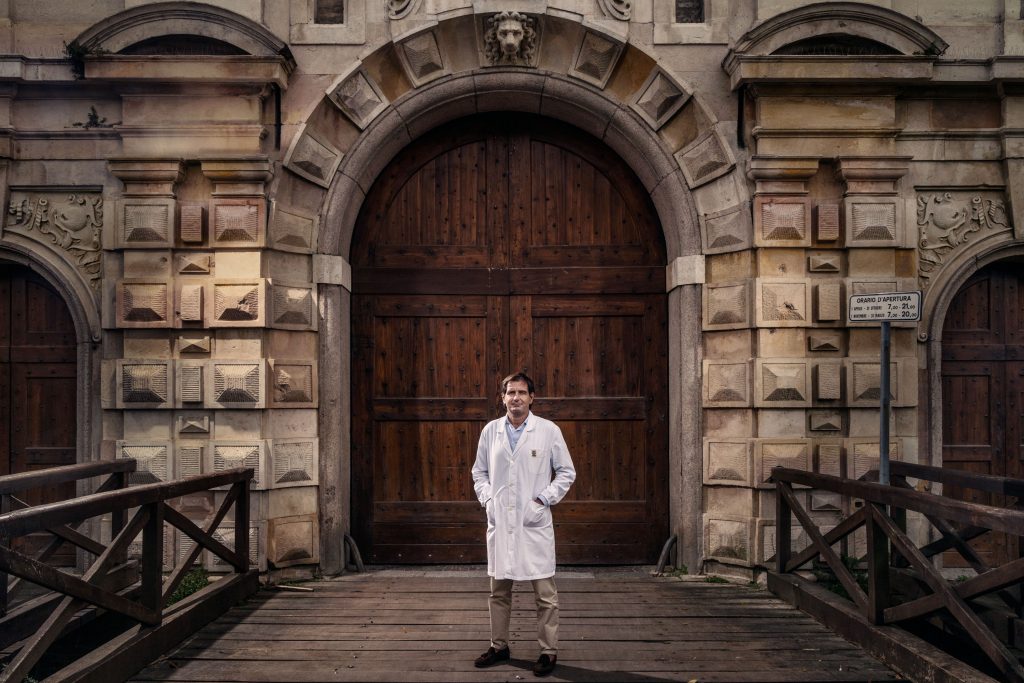
A journey in that Parma designated to be the Capital of Italian Culture 2020 and which, in a certain way, pays homage to its community through your project. A tribute that will cover the whole city for a month and that aims to enter the new urban landscape. How will this happen and with what strength do you want to dialogue with people?
M. GUALAZZINI: As a photojournalist my work finds its main achievement once it is published in a newspaper, a destination that in this case did not seem to work. Since Signaroldi mainly deals with communication, the idea was precisely to use a “communication” that could really reach everyone. And which of all the means available could best satisfy this need? Billboards. Therefore, we went for a serial communication, basic, immediate, outdoors, without barriers and without the risk of such feared gatherings. Give billboards something that was not a commercial message, but a warning, a memento. The portraits ennoble them, they sell nothing, on the contrary, they almost take on a civil value. People pass by, and all of a sudden they recognize someone they may have already glimpsed might recognize. And it’s not the premium league player advertising a shampoo, but the cashier he saw 5 minutes earlier, the pharmacist, the neighbor’s caregiver. Why is he celebrated there as a star? And it is precisely at that moment that the short circuit should be created, triggering a curiosity in the distracted passer-by and making the message concrete, establishing a dialogue between the individual’s experience and the community in which it is reflected, or vice versa.
M. ILLICA MAGRINI: Urban involvement focuses on the impact of the photographic image. In addition to being in public and unexpected places, the portraits show ordinary people and tell us how, in the grueling months of the lockdown, many kept working so that no one was left behind. A visual message that, in addition to offering hope, intends to make us feel part of the same battle which, unfortunately, is not over yet.
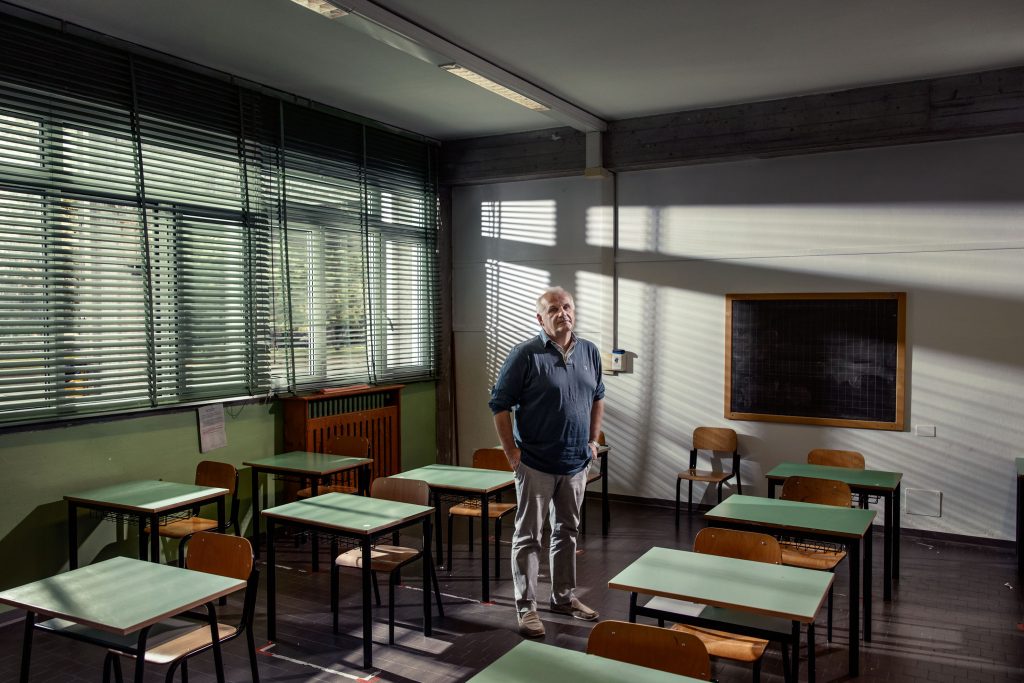
Resilienti 2020 is told through a photographic survey. Who are the subjects you have chosen and how do they relate to the history of the city and its upheaval due to the Coronavirus?
M. GUALAZZINI: The choice, apart from two or three people that I wanted, that I felt the need to photograph – like Dr. Nouvenne who was the spark of the entire project – was pretty “random”. We immediately identified macro-sectors: volunteering, school, doctors, nursing homes, the media and from there we then selected subjects that corresponded to those “common” requirements we were looking for. Take pharmacies, for example, the pharmacists who exposed themselves to the risk were so many. There is no real answer to “why this and not that”… the pharmacist could easily not have been Filippo Sicuri, but anyone who had been involved and active in that period. I just hope that “the other pharmacists” understand that Filippo simply becomes a symbol for all the others… because the project starts from Parma on 20 subjects, but is exponential and replicable in any city of any nation.
P. GERBONI: The subjects are ordinary people who in their small way have given a great testimony of resilience. They are on the front line, they are the symbol of the community, of the city that does not give up, in spite of everything. Each of them represents a social category (a nurse, a doctor, a mother, the head of the Red Cross, etc…) although we had to make choices, ideally the number of categories could be very large. The subjects are immersed in the city, there is always a dialogue with the space where they are: sometimes it is declared, other times more whispered but with the same thread. Covid has upset our lives and the environment in which we live but these little big gestures of normal people give us strength and hope for the future.
The exhibition, conceived as an ephemeral urban apparatus, is historicized, however, through a website which collects photographic and editorial testimonies resilienti2020.it is a digital form of R_Esistence?
G. L. SIGNAROLDI: The world has changed many times over the course of history, and it is changing even now. Covid-19 has canceled the last resistance to the digital revolution but the screen is not a substitute for our emotions. What we are, what we have been and will be depends only on us and on the way in which we know how to use the tools that technology makes available to us. Resilienti2020.it is a tool at the service of the design idea, a digital extension that amplifies the message of the ephemeral exhibition and brings it into the lives of people who want to participate in the story. The virus has radically changed our habits forever: how we eat, how we relate to others, how we play sports, how we work. Also how we participate in the culture, which is the real antidote to the pandemic. Because it comes straight to our hearts and minds, where we build the real R_Existence.
M. ILLICA MAGRINI: To complement the images, I collected and wrote the testimonies of the people portrayed. A sort of interview on their choices and the actions during the spring lockdown. It was a very intense exchange: some of them shared the experience of those hard days for the first time. I therefore chose to write the text in first person, to free them as much as possible from my journalistic presence. With the team, we agreed it was the best thing: I wanted the words to arrive as they had reached me, in the purest, warmest and most direct way possible. On the site, the text becomes an integral part of the photographic story to delve into what these people have felt, thought and seen. I think it is an important part of the project: a persistent way to tell these times that are not only made up of anger and pain, but also of a humanity that resists, despite everything.
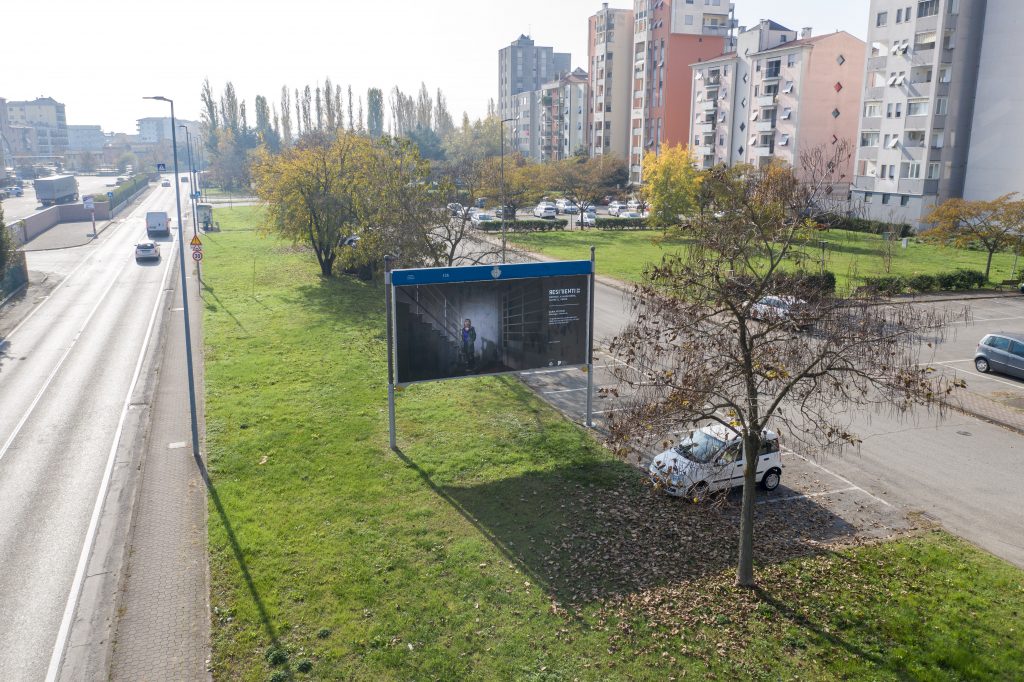
Is resilience also an act of memory?
M. GUALAZZINI: I believe that the mind tends to process the trauma and to give it a shape to be able to metabolize and move on … I don’t think resilience itself is necessarily an act of memory. In fact, I do not exclude that in some cases, as a defense against a trauma, we may tend to remove it completely. It is history, and even more so when it is collective, that gives such trauma back to us. Paraphrasing Manzoni: the story “lines up again in battle” the protagonists, those terrible days and nights. And when it happens, not now, but years from now, when we will have to confront this trauma that we will have faced and overcome as a community, I hope that, through these portraits, a testimony will remain of what these people have done for us.
P. GERBONI: It must be. What we have been through will be studied in history books: people make history. It is important not to forget the efforts we made. I will always carry within me the power of these faces and their stories.
G. L. SIGNAROLDI: I believe that memory is a basic ingredient of resilience. I think that resilience is the result of remembering with images, a dimension that reconfigures the vision of a new world, or at least of one of the thousand versions of it: it is our knowing how to see, knowing how to transform the way in which we will be able to be with others, in which we will be able to evolve our personal idea of community.
M. ILLICA MAGRINI: I believe that resilience acts in a physical and profoundly intimate way in people, but also in communities. In fact, it is also an act of memory that allows you to draw on experience to find balance even after the most abrupt shock. In this sense, our project intends to help inscribe these testimonies in our social body, because only if we remember them can they be a source of new strength and momentum.
The story of Resilienti 2020. Dietro la maschera, oltre il virus by those who imagined, lived, created and published it is the counterpart of a suspended time that does not give up and that tries, in every way, to write a piece of history, a memento mori but also a memento vitae. Whether resilience is an aspect of memory – denied or renewed –doesn’t matter now. The resilience created by this project investigates the unseen with strength and expressive power, a parallel to that unknown that Covid-19 has brought to the center of an empty and at the same time full scene. Being resilient is a way to understand, to cling to knowledge and draw a saving path from it. Unfortunately, there is often no happy ending and here, an “ephemeral exhibition project” like the one that dresses Parma in almost 100 points of its streets, regardless of the center or suburbs, is what Gualazzini calls a “short circuit” Since it must give life to new synapses, as a flash in the darkness of existence, in the great metaphor that is human life.
© Photographs from RESILIENTI 2020. Dietro la maschera, oltre il virus by Marco Gualazzini (Concept and Reportage), Gian Luca Signaroldi (Concept, Communication and Marketing), Pietro Gerboni (Reportage),Mariachiara Illica Magrini (Research and Editorial coordination)
November 23, 2020


